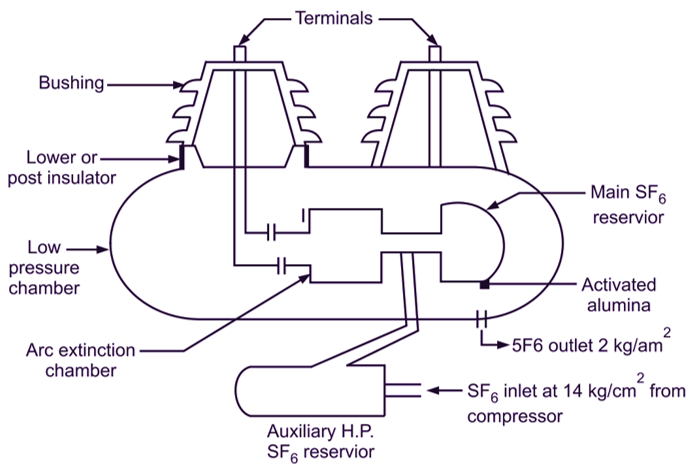Now the turning of this century has comprehensively switching on to the use of sulphur Hexafluoride (SF6) circuit breakers instead of OCB and ABCBs, etc.
The sulphur hexafluoride gas is an inert, heavy good dielectric strength and better arc quenching properties. Its dielectric strength can be increased by increasing the pressure of the gas. Nowadays this gas is extensively used in electrical equipments, like high voltage metal enclosed cables, HV. metal clad switch gears, capacitors, circuit breakers, C.T. and terminal bushings etc. SF6, gas is in liquid shape and is generally supplied by chemicals firms. The production cost can be low when manufactured in bulk quantity.
The gas is colourless, odourless, non-toxic, non-inflammable, it is heavy say 5 times the air at 20°C. The heat transfer properties are 2.5 times than that of air (thus the current carrying capacity of the conductor is increased by 250
These circuit breakers are designed as double pressure type (nowadays obsolete) and single pressure puffer type. It is a popular designed ranging from 3.6 KV to 760 KV circuit breakers.
Double Pressure Dead Tank Type SF6 Circuit Breaker

Fig. 1: SF6 Circuit Breaker (Double pressure type)
The gas from the compressor is taken into auxiliary H.P. reservoir through the inlet as shown in Fig. 1. It is then admitted into main SF6 reservoir at 14 kg/cm2 from which it travels axially to the arc extinction chamber where the arc is formed. The axial flow of this gas takes away the heat and arc is cooled and is extinguished. The arcing time becomes less as the dielectric strength is more. Finally, the gas reaches L.P. chamber from which it is pumped to the compressor unit from which it is taken to the auxiliary H.P. cylinder for the next operation. The Circuit Breaker consists of
- Gas System
- Tank
- Interrupted or arc extinction chamber.
Gas System: The gas follows closed path as indicated above and do not escape to the atmosphere. The activated alumina (Al203) filters the gas and absorbs the products which have failed to recombine.
Tank: The tank is earthed.
Arc Extinction Chamber: The chamber is located axially in the tank and is supported by insulators. The arc extinction process takes place in this chamber by the axial flow of SF6 gas. This type is becoming absolute and puffer type is coming up as explained hereafter.
Advantages of SF6 Circuit Breaker
- Its working is silent with good overload capacities. The failure from moisture can be avoided by using sealed constructions.
- It has ability to interrupt low and high fault current inductive and capacitive current with minimum fault clearing time.
- Some gas is recirculated, hence the quantity of SF6 gas required in the long run is small.
- Maintenance is minimum.
- No over voltage problems and no contact replacement because the contact corrosion is very small (because gas is inert).
- For the same rating size of SF6 Circuit Breaker is small as compared to Air blast C.B. because dielectric strength of SF6 is high. Hence, clearance is less and size is smaller
- Excellent arc extinction capacity, the insulating physical and chemical properties are advantageous and the possibility of fire and explosion is very less.
Disadvantages of SF6 Circuit Breaker
- Special material is required for construction because of the sealing problems.
- The entry of moisture in a gas causes the failure of C.B. but the latest design takes due care about it.
Comparison of SF6 Circuit Breaker with Air Blast Circuit Breaker
| Features | Air Blast C.B. | SF6 C.B. |
| Compressed air | Required | Not required |
| Gas | Not required | SF6 gas required |
| Number of interrupters | 6 to 12 | 2 to 4 |
| Maintenance | More | Less |
| Pressure | 30 bars | 5 bars |
| Switch ng | Excellent | Excellent |
| Breaking time | 2 cycles | 2.5 cycles |
| Medium | Fresh every time | Same forever |
| Construction | Complex | Compact/simple |
| Cost | Very high | Medium |
| Use | Used early days | Used nowadays |